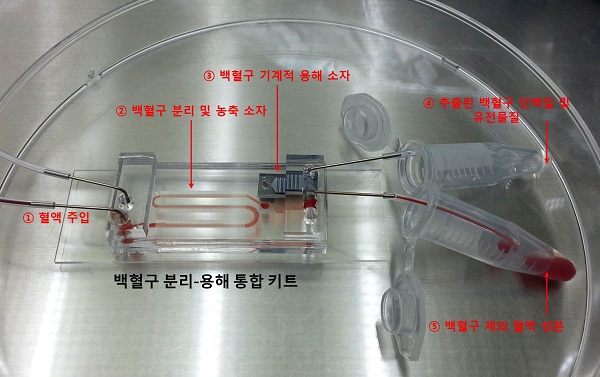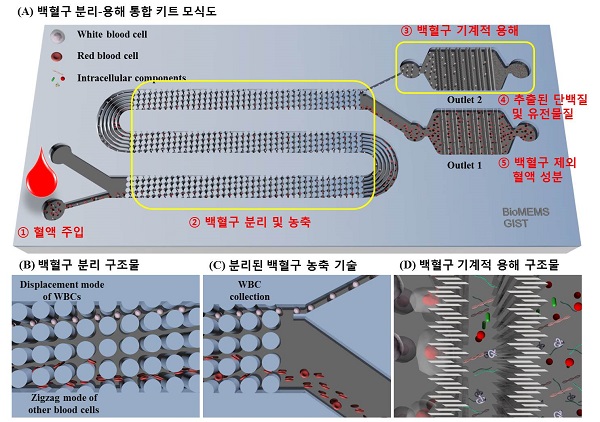Media Center
A multimedia mosaic of moments at GIST
GIST Excellence
[Press Release] Professor Sung Yang"s research team developed an integrated microfluidic chip to separate white blood cells from whole blood without using reagents
- 엘리스 리
- REG_DATE : 2015.10.23
- HIT : 777
Diagnosis of AIDS and Ebola made easier and faster!
Research contributing to quick medical diagnosis using an integrated microfluidic chip
to separate white blood cells from whole blood without using reagents or a centrifuge is published in Scientific Reports

(Figure 1) The research team developed an integrated microfluidic chip that can extract intracellular proteins and nucleic acids for diagnostic purposes in real-time as shown on the right.
GIST (Gwangju Institute of Science and Technology) researchers have developed a kit that is a quarter of the size of a credit card to automatically separate white blood cells from whole blood without using reagents. The results are expected to contribute to easier and faster diagnosis of viral infectious diseases, such as AIDS or Ebola.
GIST Professor Sung Yang (corresponding author) led the research that was conducted by Ph.D. candidate Jongchan Choi who was the first-author of the paper entitled "On-Chip Extraction of Intracellular Molecules in White Blood Cells from Whole Blood," which was published in Nature"s online edition of Scientific Reports on October 14, 2015. Their research was partially supported by grants from the National Research Foundation of Korea (NRF) and the institute of Medical System Engineering (iMSE) at GIST.
Typically, viral infections are diagnosed by detecting viral antibodies or antigens within a person"s bodily fluid, such as their saliva, urine, blood, and especially from their blood plasma. For diagnostic purposes, it is important to remove white blood cells from the blood to determine whether or not they contain any viral biomarkers as viruses require host cells to replicate. However, diagnosing diseases currently requires the use of special reagents and equipment like a centrifuge to separate white blood cells from whole blood. Unfortunately, such equipment are not readily available in remote or rural areas throughout the world.

(Figure 2) (A) A schematic illustration of the integrated sample preparation chip for continuous white blood cell separation and mechanical lysis. (B) Lateral displacement of which blood cells is achieved by micropost arrays while red blood cells flow in a zigzag mode. (C) Self-enrichment of white blood cells is realized by controlling the width ratio between two outlets. (D) White blood cells are simultaneously ruptured by mechanical nanoblade arrays with ultra-sharp edges to release the intracellular components in a continuous fashion.
The GIST research team developed an integrated microfluidic chip that is only a quarter of the size of a credit card (5 cm x 2 cm) to continuously separates white blood cells from whole blood while automatically rupturing the white blood cells to extract intracellular proteins and nucleic acids for diagnostic testing without having to use reagents or a centrifuge. This process is achieved by the use of polydimethylsiloxane microposts that creates physical channels that separates white blood cells from whole blood, and wet-etched silicon nanoblades are used to rupture and extract intracellular components of the white blood cell, which are then separately collected for diagnostic testing.
The white blood cell separation efficiency of the integrated microfluidic chip exceeded 99% (nearly 100% in many cases), and yielded 120% more intracellular protein when compared to conventional separation methods.
Based on polymerase chain reaction (PCR) testing, the integrated microfluidic chip demonstrated that it can extract HIV proviral DNAs from infected cells with a population as low as 102/μl, suggesting its potential application for point-of-care testing for infectious diseases in developing countries.

Professor Sung Yang said, "With further development, the technology represented by our integrated microfluidic device will make it easier to more quickly diagnose infectious diseases by extracting and testing biomarkers from a patient"s blood, which will help prevent unnecessary disease transmission, especially in remote areas with limited medical resources."